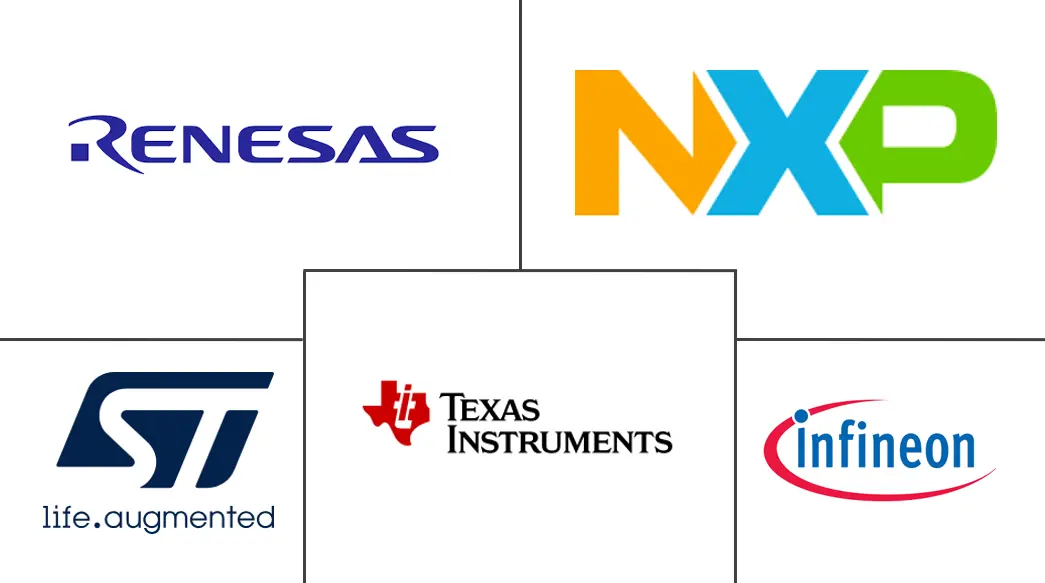Automotive Semiconductor Market Size and Share
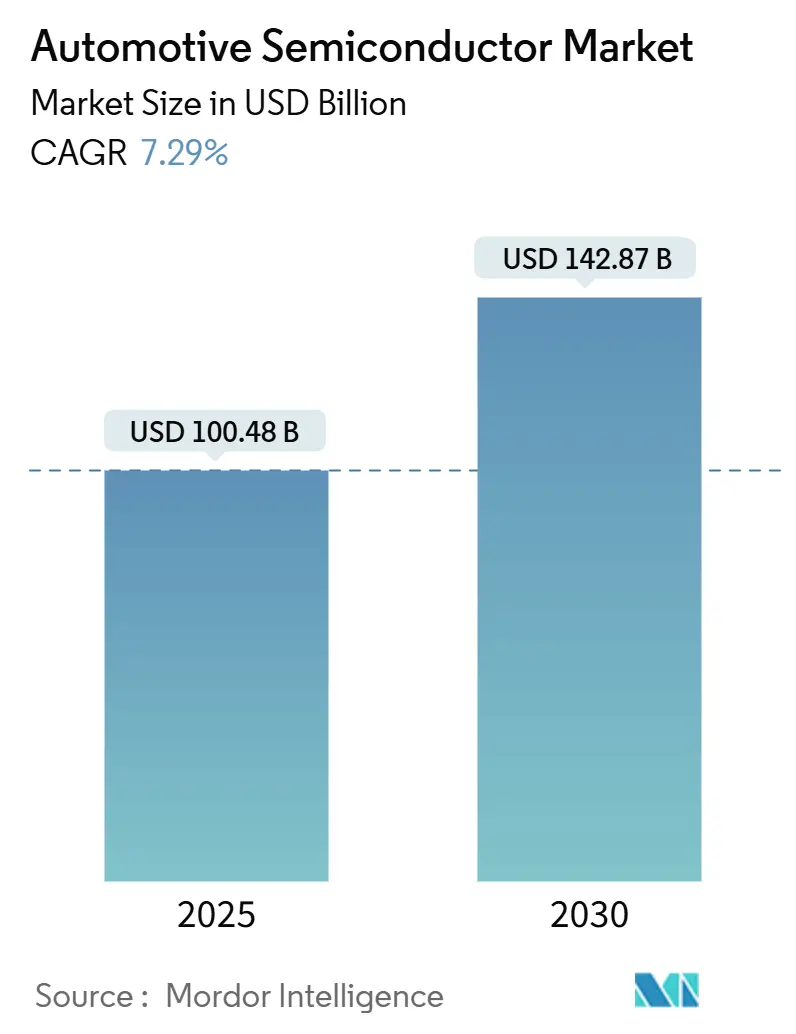
Automotive Semiconductor Market Analysis by Mordor Intelligence
The automotive semiconductor market size reached USD 100.48 billion in 2025 and is forecast to expand at a 7.29% CAGR, lifting the market value to USD 142.87 billion in 2030. Mounting electrification mandates, rapid adoption of advanced driver-assistance features, and the pivot toward software-defined vehicles are pushing silicon content higher across every vehicle class. Automakers are racing to secure long-term foundry capacity, and the spread of zonal architectures is concentrating spend on high-performance processors, memory, and power devices. Supply-chain resiliency programs combined with multi-sourcing strategies are reshaping procurement, while wide-bandgap devices and integrated power modules open fresh design-in opportunities that sustain pricing power even as mature-node components normalize.
Key Report Takeaways
- By device type, integrated circuits held 86.3% of the automotive semiconductor market share in 2024, whereas sensors and MEMS are projected to record an 8.5% CAGR through 2030.
- By business model, design/fabless vendors accounted for 67.3% of the automotive semiconductor market size in 2024, while the same cohort is expected to register the highest growth at an 8.7% CAGR to 2030.
- By geography, Asia-Pacific captured 63.2% of the semiconductor market size in 2024 and is projected to grow at a 7.1% CAGR, maintaining its lead despite active diversification in North America and Europe.
Global Automotive Semiconductor Market Trends and Insights
Drivers Impact Analysis
| Driver | (~) % Impact on CAGR Forecast | Geographic Relevance | Impact Timeline |
|---|---|---|---|
| Increasing vehicle production in emerging economies | +1.2% | Asia-Pacific, Latin America, MEA | Medium term (2-4 years) |
| Rising demand for advanced safety and comfort systems | +1.8% | Global, with early adoption in North America and the EU | Short term (≤ 2 years) |
| Electrification is boosting semiconductor content per vehicle | +2.1% | Global, led by China and the EU regulatory mandates | Medium term (2-4 years) |
| Zonal E/E architectures and software-defined vehicles spur high-end processors | +1.5% | North America and EU premium segments, expanding globally | Long term (≥ 4 years) |
| Government subsidies for auto-grade foundry capacity | +0.8% | US, EU, China, South Korea | Long term (≥ 4 years) |
| SiC and GaN power devices adoption in EV powertrains | +1.3% | Global EV markets, concentrated in China, the EU, and North America | Medium term (2-4 years) |
| Source: Mordor Intelligence | |||
Electrification Boosting Semiconductor Content Per Vehicle
Battery-electric platforms add power electronics, battery-management ICs, and thermal-management controllers absent in internal-combustion models. The transition from 400 V to 800 V electrical systems demands silicon-carbide (SiC) MOSFETs that sustain higher voltages with lower switching losses. Infineon’s trench-based SiC super-junction devices deliver 40% lower resistance and 25% higher current capability, enabling smaller traction inverters and faster charging times.[1]NXP Semiconductors, “NXP Extends Industry-First 28 nm RFCMOS Radar One-Chip Family,” nxp.com NXP’s ultra-wideband wireless battery-management system removes heavy cabling, trims vehicle weight, and frees space for higher energy-density packs. Higher-voltage architectures also need reinforced isolation, gate drivers, and precision current sensors that command premium average selling prices. Collectively, these factors lift semiconductor dollar content per EV to multiples of conventional vehicles.
Rising Demand for Advanced Safety and Comfort Systems
Level 2+ driver-assistance packages integrate multi-modal sensor suites—radar, LiDAR, and high-resolution cameras—producing terabytes of data per hour. Real-time sensor-fusion workloads require application-specific processors and embedded neural-network accelerators. NXP’s 28 nm RFCMOS radar one-chip family now offers 360-degree coverage and built-in AI object classification, cutting bill-of-materials and simplifying system architecture. Complementary optical innovations, such as ams OSRAM’s eight-channel pulsed lasers, deliver 1,000 W peak optical power, extending LiDAR range for highway autopilot features. Regulatory demands under ISO 26262 reinforce the adoption of redundant compute paths and safety diagnostics, further elevating silicon spend.
Zonal E/E Architectures and Software-Defined Vehicles Spur High-End Processors
Moving from dozens of distributed electronic control units to a handful of zone controllers reduces wiring complexity but concentrates compute demand on advanced microcontrollers. NXP’s S32K5 family exploits a 16 nm FinFET process and embedded magnetoresistive RAM to deliver 15-fold faster write speeds than flash, enabling over-the-air updates without compromising duty-cycle limits. Infineon and Flex jointly rolled out a reference zone-controller platform that integrates gateway, power distribution, and motor control functions, shortening automaker design cycles. As software-defined vehicles gain traction, automakers increasingly benchmark semiconductor roadmaps on smartphone-class refresh rates, accelerating demand for high-performance automotive-grade silicon.
SiC and GaN Power Devices Adoption in EV Powertrains
SiC MOSFETs and gallium-nitride (GaN) HEMTs switch faster and run hotter than silicon IGBTs, shrinking inverter footprints and enhancing range. Global 8-inch SiC wafer capacity is ramping across 14 announced fabs, including onsemi’s South Korea expansion and STMicroelectronics’ Catania megafab. Yet substrate scarcity keeps prices elevated; Renesas exited the SiC segment after terminating its Wolfspeed partnership, citing unfavorable economics. GaN devices target on-board chargers and DC-DC converters; Navitas recently secured AEC-Q101 qualification for its Gen-3 Fast SiC technology, positioning GaN as a viable option for 6.6 kW and higher chargers.[2]ams OSRAM, “New Era for LiDAR Applications,” ams-osram.com
Restraints Impact Analysis
| Restraint | (~) % Impact on CAGR Forecast | Geographic Relevance | Impact Timeline |
|---|---|---|---|
| High cost of advanced-feature vehicles | -0.9% | Global, particularly price-sensitive emerging markets | Short term (≤ 2 years) |
| Persistent supply-chain constraints and chip shortages | -1.1% | Global, with an acute impact in the Asia-Pacific manufacturing | Short term (≤ 2 years) |
| Scarcity and cost of wide-bandgap substrates (SiC/GaN) | -0.7% | Global, affecting premium EV segments | Medium term (2-4 years) |
| Lengthy automotive qualification cycles slow time-to-market | -0.5% | Global, impacting all automotive semiconductor categories | Long term (≥ 4 years) |
| Source: Mordor Intelligence | |||
Persistent Supply-Chain Constraints and Chip Shortages
Automotive lead times remain longer than consumer electronics norms, especially for mature-node microcontrollers, sensors, and analog components. Specialized automotive-grade packaging capacity is heavily concentrated in East Asia, creating single points of failure. To address geographic risk, GlobalFoundries and NXP broadened their collaboration on 22FDX production split between Dresden and New York, giving automakers a dual-sourced pathway that meets Grade 1 qualification.[3]Infineon Technologies AG, “Infineon and Flex Showcase Zone Controller Design Platform,” infineon.com Automakers are now embedding foundry capacity clauses into long-term supply agreements to shield vehicle launches from component shortages.
Scarcity and Cost of Wide-Bandgap Substrates (SiC/GaN)
Substrate costs can equal half the finished device cost for SiC and GaN, and pristine wafers demand long crystal-growth cycles and meticulous defect screening. Wolfspeed dominates 150 mm-substrate output, though STMicroelectronics and Infineon are vertically integrating to reduce dependence. Limited supplier diversity inflates prices and lengthens qualification timetables, putting premium EV platforms at the forefront while mass-market segments wait for cost curves to fall. Gallium and indium material constraints add another layer of volatility to GaN device economics.
Segment Analysis
By Device Type: Integrated Circuits Drive Market Evolution
Integrated circuits represented USD 86.6 billion of the automotive semiconductor market size in 2024 and are forecast to post an 8.5% CAGR through 2030. Microcontrollers lead the pack as gateway, body, and powertrain domains migrate to higher clock speeds and expanded memory footprints. Infineon captured 28.5% share of the automotive semiconductor market within microcontrollers by expanding its AURIX family to a RISC-V architecture, reinforcing the segment’s technological churn. Analog ICs retain a pivotal role in power management, sensor interfacing, and voltage regulation, although system-on-chip consolidation exerts price pressure on older node devices.
Discrete devices, optoelectronics, and sensor/MEMS categories account for the balance. Discrete IGBTs and MOSFETs underpin traction inverters and relay-replacement switches, but design-ins increasingly favor integrated power modules that collapse multiple dies into a single substrate. Optoelectronics benefit from adaptive LED lighting and emerging LiDAR units, while MEMS accelerometers, gyros, and pressure sensors proliferate across ADAS and comfort features. Zonal architectures bundle former standalone components into higher-value ICs, explaining why integrated circuits continue to outpace the wider automotive semiconductor market.
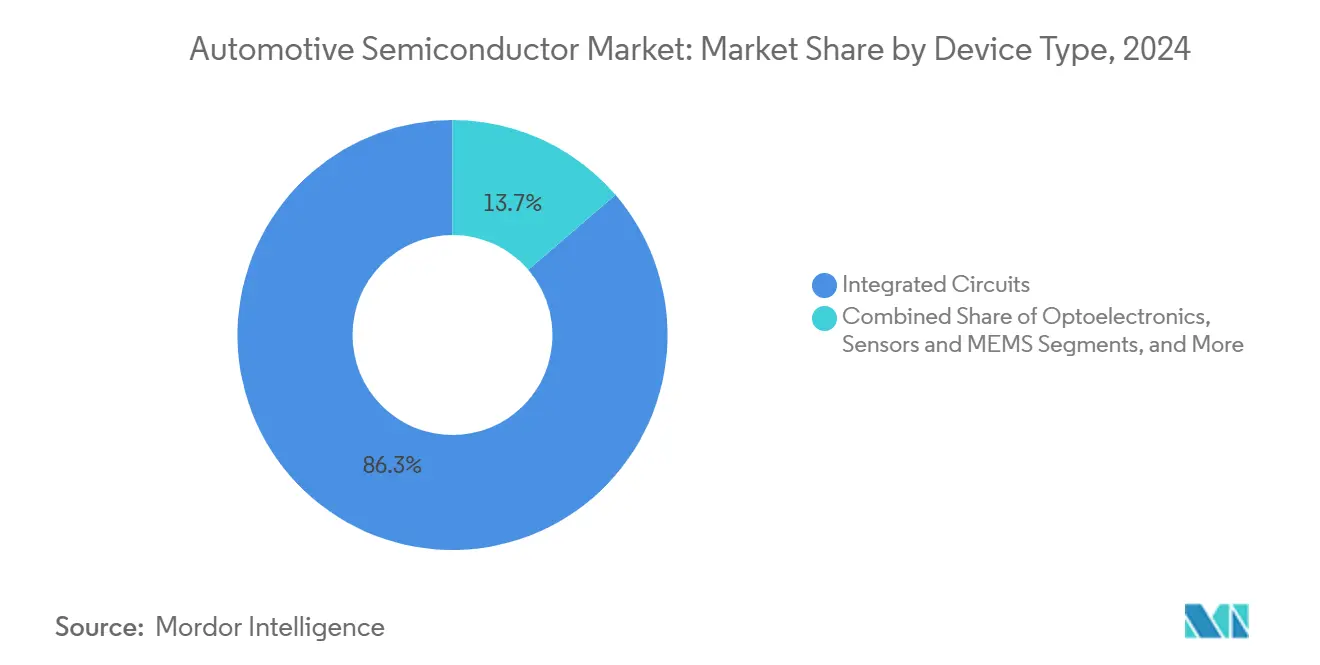
Note: Segment shares of all individual segments available upon report purchase
By Business Model: Fabless Vendors Reshape Industry Dynamics
Design/fabless firms controlled USD 67.6 billion of the automotive semiconductor market size in 2024 and are projected to expand at an 8.7% CAGR. Automakers seek rapid silicon iterations aligned with software release cadences; fabless houses such as NXP, Qualcomm, and AMD leverage leading-edge foundry access without owning capital-intensive fabs. NXP’s USD 307 million acquisition of edge-AI specialist Kinara underscores how fabless players buy niche IP to accelerate feature roll-outs.
IDMs retain legacy sockets in power, analog, and safety-critical domains where long product lifecycles and proven manufacturing controls remain paramount. To keep pace with advanced nodes, IDMs increasingly strike foundry partnerships; STMicroelectronics co-develops 5 nm automotive platforms with TSMC while maintaining internal 90 nm and 40 nm capacity for long-tail parts. Hybrid outsourcing models are becoming common, yet the system integration complexity of software-defined vehicles favors the agile tape-out cycles typical of fabless vendors.
Geography Analysis
Asia-Pacific commanded 71.5% of automotive semiconductor shipments in 2024 and is expected to grow at a 7.8% CAGR to 2030. China’s new-energy vehicle penetration surpassed 39% in 2024, and more than 300 domestic chip design firms were established that year to chase Beijing’s 100% sourcing target. Shanghai-based Horizon Robotics secured major design wins, claiming 33.97% share of local ADAS processor volume, while foundry SMIC set a 10% automotive revenue goal for 2026 production. India is scaling its semiconductor ecosystem under the USD 76,000 crore India Semiconductor Mission; approved proposals total USD 21 billion, including display and ultralow-power AI partnerships between Tata Electronics, Himax, and PSMC.
North America ranks second, buoyed by the USD 39 billion CHIPS and Science Act incentives and marquee projects such as TSMC’s USD 6.6 billion Arizona expansion. Tesla inked a USD 16.5 billion, eight-year wafer-supply pact with Samsung, locking in advanced-node capacity for autonomous-driving silicon manufactured in Texas. Canada’s Semiconductor Council added Infineon as a member to drive policy alignment on electric-mobility value chains.
Europe pursues strategic autonomy via the EUR 43 billion (USD 48.6 billion) EU Chips Act, aiming to capture 20% global output by 2030. STMicroelectronics broke ground on an integrated SiC fab in Catania, Italy, while a Dresden consortium secured EUR 5 billion (USD 5.7 billion) in state aid for a new logic facility. Automakers such as Stellantis co-develop power-conversion systems with Infineon, ensuring preferential access to SiC MOSFET supply.[4]Navitas, “Navitas Qualifies Gen-3 Fast SiC to Auto-Grade,” navitassemi.com The Middle East, Africa, and South America remain nascent but exhibit double-digit EV adoption trajectories, positioning them as future growth nodes once local supply chains mature.
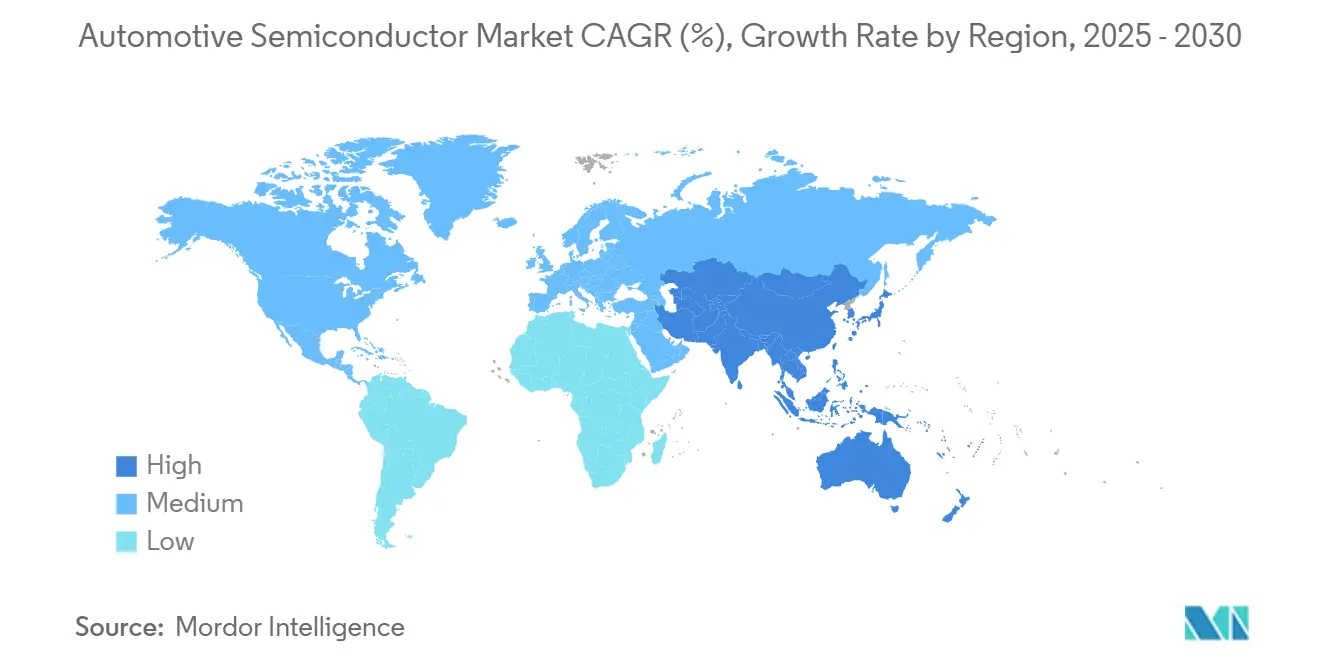
Competitive Landscape
The automotive semiconductor market exhibits moderate concentration: the top five suppliers collectively control a significant share of global revenue, reflecting entrenched customer relationships and broad AEC-Q qualified portfolios. NXP consolidates edge-AI and radar IP; Infineon leverages scale in power and microcontrollers; Renesas holds strength in legacy mixed-signal designs; STMicroelectronics dominates SiC device supply; and Texas Instruments sustains a vast catalog of analog building blocks. Strategic M&A continues: Infineon acquired Marvell’s automotive Ethernet assets for USD 2.5 billion to fortify zonal-networking solutions, while ROHM and Denso formed a development alliance focused on analog ICs for autonomous systems.
Chinese entrants intensify competition. BYD Semiconductor captured 28.9% of the domestic IGBT module segment by integrating devices into its blade-battery drivetrain. OEM in-house silicon programs multiply; General Motors co-develops custom compute with Qualcomm, while Hyundai taps Infineon for SiC traction inverters slated for 2027 volume production. The shift toward software-defined vehicles tilts bargaining power toward companies controlling critical IP around safe-compute platforms, neural-network toolchains, and connectivity stacks.
Emerging white-space opportunities span automotive-grade accelerators for transformer-based AI models, ultra-low-latency Ethernet PHYs for deterministic communication, and printed-circuit thermal-management materials compatible with SiC junction temperatures. Suppliers able to marry leading-edge process technology with automotive functional-safety know-how are best placed to capture the next design cycles.
Automotive Semiconductor Industry Leaders
-
Infineon Technologies AG
-
NXP Semiconductors N.V.
-
STMicroelectronics N.V.
-
Texas Instruments Inc.
-
Renesas Electronics Corp.
- *Disclaimer: Major Players sorted in no particular order
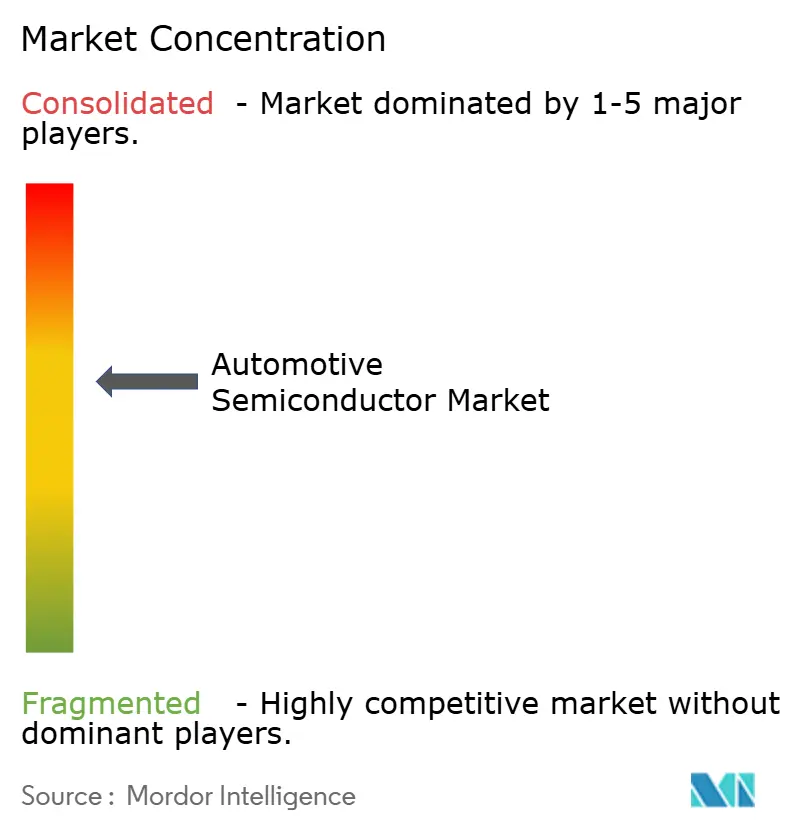
Recent Industry Developments
- July 2025: Tesla and Samsung Electronics announced a USD 16.5 billion wafer-supply agreement for AI processors to be produced at Samsung’s new Texas fab, securing long-term 4 nm and 3 nm capacity for Tesla’s autonomous-driving roadmap.
- May 2025: Renesas Electronics withdrew from silicon-carbide device development, ending its Wolfspeed partnership and reallocating R&D toward mixed-signal MCUs.
- May 2025: Denso and ROHM launched a strategic alliance covering joint analog-IC development, shared raw-material sourcing, and co-located SiC module manufacturing.
- May 2025: Infineon introduced trench-based CoolSiC super-junction MOSFETs, providing 40% lower resistance for traction inverters; Hyundai committed to first-wave adoption in 2027 model-year EVs.
Research Methodology Framework and Report Scope
Market Definitions and Key Coverage
Our study defines the automotive semiconductor market as the yearly revenue generated from new, application-grade integrated circuits, discrete power devices, sensors, memories, and analog components that are designed, fabricated, or packaged expressly for on-road passenger and commercial vehicles. The scope stretches from basic engine-control chips to high-bandwidth SoCs used in ADAS, but excludes aftermarket remanufactured parts and generic consumer semiconductors designed for non-automotive use.
Scope exclusion: refurb-grade chips sold through independent distributors are not covered.
Segmentation Overview
- By Device Type (Shipment Volume for Device Type is Complementary)
- Discrete Semiconductors
- Diodes
- Transistors
- Power Transistors
- Rectifier and Thyristor
- Other Discrete Devices
- Optoelectronics
- Light-Emitting Diodes (LEDs)
- Laser Diodes
- Image Sensors
- Optocouplers
- Other Device Types
- Sensors and MEMS
- Pressure
- Magnetic Field
- Actuators
- Acceleration and Yaw Rate
- Temperature and Others
- Integrated Circuits
- By Integrated Circuit Type
- Analog
- Micro
- Microprocessors (MPU)
- Microcontrollers (MCU)
- Digital Signal Processors
- Logic
- Memory
- By Technology Node (Shipment Volume Not Applicable)
- < 3nm
- 3nm
- 5nm
- 7nm
- 16nm
- 28nm
- > 28nm
- By Integrated Circuit Type
- Discrete Semiconductors
- By Business Model
- IDM
- Design/ Fabless Vendor
- By Geography
- North America
- United States
- Canada
- Mexico
- South America
- Brazil
- Argentina
- Rest of South America
- Europe
- Germany
- United Kingdom
- France
- Italy
- Spain
- Rest of Europe
- Asia-Pacific
- China
- Japan
- South Korea
- India
- Rest of Asia-Pacific
- Middle East and Africa
- Middle East
- Saudi Arabia
- United Arab Emirates
- Turkey
- Rest of Middle East
- Africa
- South Africa
- Nigeria
- Egypt
- Rest of Africa
- Middle East
- North America
Detailed Research Methodology and Data Validation
Primary Research
Mordor analysts interviewed chip designers, tier-1 electronics suppliers, and procurement managers across Asia-Pacific, Europe, and North America. These conversations clarified average semiconductor content per BEV versus ICE models, verified channel mark-ups, and stress-tested assumed ASP erosion curves before forecasts were locked.
Desk Research
We began by mapping the market universe through publicly available tier-1 data sets, WSTS monthly automotive IC billings, OICA vehicle production tallies, IEA EV stock numbers, UN Comtrade HS-8541/8542 trade flows, and technical papers indexed in IEEE Xplore. Company 10-Ks, investor decks, and trade association portals such as SEMI and ACEA provided unit-cost clues and design-win disclosures. Supplementary insight was pulled from D&B Hoovers financials and Questel patent analytics, enabling us to gauge technology diffusion speeds. The sources cited above illustrate, not exhaust, the reference pool consulted.
Market-Sizing & Forecasting
A blended top-down build, vehicle production volumes multiplied by semiconductor bill-of-material values that vary by drivetrain, safety grade, and automation level created the first demand pool, which we cross-checked with selective bottom-up roll-ups of leading supplier revenues. Key variables inside our model include: 1. Average chips-per-vehicle, 2. Regional BEV penetration trajectory, 3. Power device ASP migration from silicon to SiC, 4. Memory density per infotainment stack, and 5. WSTS automotive IC shipment indices.
Multivariate regression on these drivers underpins a forecast for the specified period, while scenario analysis captures supply chain shocks. Gaps in the bottom-up corroboration, such as missing private-company revenue splits, were bridged using channel shipment ratios derived from customs data.
Data Validation & Update Cycle
Outputs flow through dual analyst reviews that flag +/-5% variances against external shipment signals. When quarterly OEM production deviates materially, we refresh the model ahead of the scheduled annual update, ensuring clients receive the latest viewpoint.
Why Our Automotive Semiconductor Baseline Earns Trust
Published estimates often diverge because firms choose different functional scopes, cost assumptions, and refresh rhythms.
Key gap drivers include narrower component baskets, conservative EV adoption curves, or single-source ASP assumptions used by other publishers, whereas our study blends real-world bill-of-materials audits with continuous production tracking.
Benchmark comparison
| Market Size | Anonymized source | Primary gap driver |
|---|---|---|
| USD 100.48 B (2025) | Mordor Intelligence | - |
| USD 42.9 B (2022) | Global Consultancy A | Excludes sensors and memory; older base year |
| USD 71.97 B (2024) | Industry Journal B | Uses fixed ASP decline, limited EV segmentation |
| USD 44.94 B (2023) | Regional Consultancy C | Focuses on discrete power only; no regional mix shift |
In sum, our disciplined scope selection, mixed-method modeling, and annual refresh cadence give decision-makers a baseline that aligns with observable production realities while remaining transparent and repeatable.
Key Questions Answered in the Report
How large is the automotive semiconductor market in 2025?
The automotive semiconductor market size reached USD 100.48 billion in 2025 and is forecast to grow at a 7.29% CAGR to 2030.
Which segment contributes most to revenue today?
Integrated circuits dominate, accounting for 86.3% of global revenue in 2024.
Why are fabless vendors growing faster than IDMs?
Automakers favor the shorter design cycles and advanced-node access typical of fabless vendors, driving an 8.7% CAGR for that model through 2030.
What drives demand for wide-bandgap devices?
Transition to 800 V battery systems and the need for higher power density in traction inverters spur the adoption of SiC and GaN power devices.
How are supply-chain risks being mitigated?
Manufacturers diversify geographic production, sign long-term capacity agreements, and qualify multiple foundries to reduce exposure to single-point disruptions.
Which region leads the consumption of automotive semiconductors?
Asia-Pacific leads with 71.5% share, propelled by China’s rapid electrification and large vehicle output.
Page last updated on:
